![]()
![]()
![]()
Use LEFT and RIGHT arrow keys to navigate between flashcards;
Use UP and DOWN arrow keys to flip the card;
H to show hint;
A reads text to speech;
80 Cards in this Set
- Front
- Back
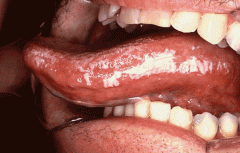
|
Hairy leukoplakia - Aetiology: EBV. Most common in HIV infection. Can also be seen in immunosuppressed transplant patients - Description: white, asymptomciatic, elevated, unremovable patch. Almost always found bilaterally on lateral margins of the tongue - corrugated surface with a vertical orientation. Can also be smooth and flat - Tests: histological exam, in situ hybridisation, PCR and electron microscopy - Differentials: chronic biting, lichen planus, frictional keratosis, contact stomatitis, candidiasis - Treatment: not required (not pre-cancerous). sometimes acicylovir or valaciclovir. |
|
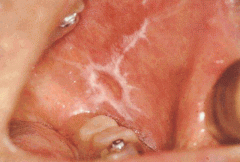
|
Lichen planus - Aetiology: relative common chronic inflammatory disease, cause unknown. T-cell mediated autoimmune phenomena involved in pathogenesis - Description: White papules that usually coalesce, forming lines (striae). Common forms: reticular, erosive. Less common: atrophic, hypertrophic. Rare: bullous, pigmented. Sites: buccal mucosa, tongue, gingiva. Lesions appears as polygonal, purple papules - Tests: Histopathological exam. Direct immunofluorescence Differentials: candidiasis, GvHD, geographic tongue, leukoplakia, erythroplakia, pemphigoid, pemphigus - Treatment: none if asymptomatic. Topical steroids (Orabase, intralesional injection). Systemic steroids for severe and extensive cases Lichenoid reactions - Show clinical and histopathological similarities to lichen planus, but caused by hypersensivitity to dental restorative materials, amalgam, composite resins, plaque accumulation. Strictly confined to the mucosa directly in contact with material; do not migrate to other sites. Lesions disappear after removal of the material. Topical steroids for a short time can help |
|

|
Linea alba - Aetiology: pressure, sucking from the buccal surface of the teeth - Description: asymptomatic, bilateral, linear elevation with a slightly whitish colour at the level of the occlusal line of the teeth. Normal consistency on palpation - No treatment required |
|

|
Nicotinic stomatitis - Aetiology: tobacco-related keratosis. Occurs exclusively on the hard palate. Associated with heavy pipe and cigar smoking. Elevated temperature is responsible - Description: redness of palate. Becomes wrinkled, diffuse greyish-white colour with numerous micronodules with punctate red centres (inflamed, dilated minor salivary gland ducts). Not pre-malignant - Tests: usually not required - Differentials: reverse smokers' palate, leukoplakia, candidiasis, lichen planus - Treatment: smoking cessation |
|

|
Contact stomatitis - Aetiology: common oral mucosal reaction to continuous contact with cinnamon (chewing gum, candy, toothpaste, drops) - Description: erythema, desquamation, erosions. White hyperkeratotic plaque. Burning sensation, pain. Areas - buccal mucosa, lateral borders of tongue, gingiva - Differentials: chronic biting, leukoedema, hairy leukoplakia, candidiasis, lichen planus - Treatment: discontinuation of product = improvement in 2 weeks. Low doses of steroid (prednisolone) for 1 week for severe and extended lesions |
|
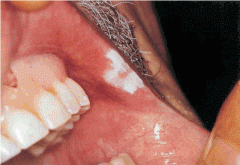
|
Chemical burn - Aetiology: application of topical agents - aspirin, hydrogen peroxide, phenol, alcohol, sodium perborate, silver nitrate, TCA, acid etch, varnishes - Description: affected mucosa covered with a white membrane due to necrosis, can be easily scraped off to leave a red, bleeding surface. Painful - Differentials: NUG, stomatitis, candidiasis, mechanical trauma, bullous diseases - Treatment: symptomatic |
|

|
Candidiasis - Aetiology: most common oral fungal infection, caused by Candida albicans. Predisposing factors: poor oral hygiene, xerostomia, mucosal damage, dentures, antibiotic mouthwashes, antibiotics, steroids, immunosuppressive drugs, radiation, HIV, haematological malignancies, neutropenia, anaemia, endocrine disorders - Description: Primary - lesions on the oral, perioral area: pseudomembranous (creamy-white, slightly elevated, removable spots or plaques. Localised or generalised, appear on buccal mucosa, soft palate, tongue, lips. Xerostomia, burning sensation, unpleasant taste) Secondary - oral lesions of mucocutaneous disease - Tests: cytology, tissue culture exam. Biopsy for chronic cases - Differentials: leukoplakia, hairy peukoplakia, lichen planus, syphilis, chemical and traumatic lesions, contact stomatitis, lupus - Treatment: topical antifungals (nystatin, azoles, amphotericin B), systemic azoles (ketoconazole, fluconazole, itraconazole) |
|
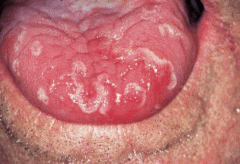
|
Geographic tongue - Aetiology: erythema migrans is a common benign condition, affecting the tongue. Exact aetiology is unknown; may be genetic - Description: multiple, well-demarcated, erythematous, depapillated patches surrounded by a slightly elevated whitish border, usually restricted to the dorsum of the tongue. Asymptomatic, lesions persist for a short time, disappear and reappear in another area. Differentials: candidiasis, lichen planus, psoriasis, Reiter syndrome Treatment: reassurance |
|
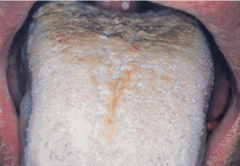
|
Hairy tongue -Aetiology: caused by marked accumulation of keratin on the filiform papillae. Unknown aetiology. Predisposing factors - poor oral hygiene, oxidising mouthwashes, antibiotics, excessive smoking, radiation therapy, stress, bacterial and Candida infections - Description: asymptomatic elongation of filiform papillae. Colour ranges from whitish, brown, black - Treatment: eliminate predisposing factors, brush tongue, local use of keratolytic agents (TCA, podophyllin) |
|
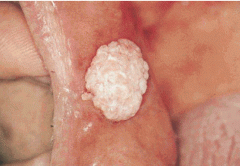
|
Verrucous carcinoma - Aetiology: low-grade variant of SCC. HPV is presumably involved - Description: exophytic white mass with a pebbly surface. Various sizes of lesions, affecting the buccal mucosa, palate and alveolar mucosa. Develops mainly in smokers over 60 years - Tests: Histopathological exam, biopsy Differentials: verrucous leukoplakia, papilloma, SCC Treatment: surgical excision |
|

|
SCC - Aetiology: multifactorial; predisposing factors - smoking, alcohol, sun exposure, poor oral hygiene, dietary deficiencies, liver cirrhosis, Candida infection - Description: Early stage - white asymptomatic plaque identical to leukoplakia OR asymptomatic, atypical red patch OR an exophytic mass. Most commonly an erosion or an ulcer with an irregular papillary surface, elevated borders, hard base on palpation. Almost always chronic and indurated Lateral border, ventral surface of tongue and lips most commonly affected - Differentials: erythroplakia, erythematous candiasis, contact reactions to dental materials, traumatic ulcer, systemic mycoses, TB - Tests: Biopsy, histopathological exam - Treatment: surgical excision, radiotherapy, chemotherapy |
|
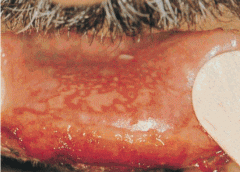
|
Radiation mucositis - Aetiology: side effect of radiation treatment of head and neck tumours - Description: Early reactions (at the end of 1st week of radiotherapy) - erythema and oedema. Later, erosions or ulcers covered by a whitish-yellow exudate. Xerostomia, loss of taste, burning and pain during mastication, swallowing, speech - Differentials: mycositis due to chemotherapy, GvHD, erythema multiforme, herpetic stomatitis, lichen planus - Treatment: supportive - cessation of radiotherapy, B-complex vitamins, sometimes low-dose steroids |
|
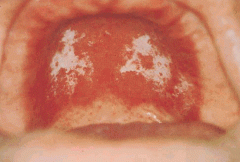
|
Denture stomatitis - Aetiology: mechanical irritation from dentures, Candida albicans, or tissue response to microorganisms living under dentures. In patients who wear dentures continuously for extended times - Description: diffuse erythema, oedema, sometimes petechiae, white spots (candida hyphae). Almost always located in the denture bearing area of the maxilla. Usually aymptomatic - Differential: allergic contact dermatitis (acrylic) - Treatment: improvement of denture fit, oral hygiene, topical antifungals |
|
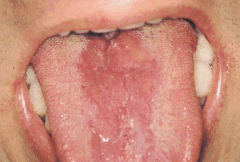
|
Erythematous candidiasis - Aetiology: high incidence in HIV patients, rarely in patients receiving broad-spectrum Ab's or steroids. Can be acute or chronic - Description: erythematous patches or large areas, usually on the dorsum of tongue. Burning sensation |
|

|
Erythroplakia - Aetiology: unknown, rarely appears on the oral mucosa - Description: asymptomatic, fiery red, well-demarcated plaque with a smooth and velvety surface. Red lesions may have white spots or small plaques - Tests: histopathological exam - Differentials: erythematous candidiasis, lichen planus, early SCC, local irritation - Treatment: surgical excision (pre-malignant) |
|

|
Desquamative gingivitis - Aetiology: autoimmune mechanism. MMP and lichen planus are the most common disease related to desquamative gingivitis - Description: erythema, oedema of marginal and attached gingiva. Facial surface more frequently affected. Spontaneous desquamation of epithelia, blister formation, areas of erosion. After mild pressure on gingiva. desquamation or haemorrhagic blisters occur (localised or generalised) - Tests: histopathological, immunological exams - Differentials: NUG, plasma cell gingivitis, plaque-related gingivitis, drug reactions, oral psoriasis - Treatment: good oral hygiene, avoidance of mechanical pressure on gingiva. Systemic treatment (corticosteroids, immunosuppressant, dapsone) depends on the identification of the underlying disease |
|

|
Haemangioma - Aetiology: developmental. Common benign proliferation of blood vessels that primarily develops during childhood - Description: capillary - flat red area with numerous small capillaries; cavernous - elevated deep red lesions with large dilates sinuses filled with blood. Characteristic sign: red colour disappears on pressure, and returns when pressure released - Tests: histopathological exam - Differentials: pyogenic granuloma, lymphangioma, traumatic haematoma, Kaposi sarcoma, malignant melanoma - Treatment: surgical excision, cryotherapy, laser therapy. Some capillary haemangiomas may regress spontaneously |
|

|
Lupus erythematous - Aetiology: autimmune chronic disease - Description: oral lesions develop in 15-25% of cases of discoid type and 30-45% of cases of SLE. Well-defined central atrophic red area surrounded by a sharp elevated border of irradiating whitish striae. Teleangiectasia, peteachiae, oedema, erosions, ulcerations and white hyperkeratotic plaques may be seen - Tests: histopathological exam, direct immunoflurorescence - Differentials: lichen planus, geographic glossitis, leukoplakia, erythroplakia, MMP, syphilis - Treatment: steroids, antimalarials |
|

|
Anaemia - Aetiology: dietary deficiencies - Description: atrophic, smooth and red tongue. Burning sensation, taste loss, angular cheilitis, erosions (maybe) - Tests: blood tests - Differentials: atrophic lichen planus, malnutrition disorders |
|
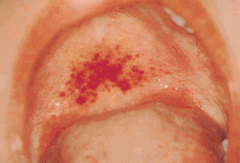
|
Infectious mononucleosis - Aetiology: acute, self-limiting, infectious disease primarily affecting children. EBV transmitted through saliva - Description: palatal petechiae, uvular oedema, tonsillar exudate, gingivitis. Generalised lymphadenopathy, hepatosplenomegaly, maculopapular skin rash, sore throat common. Prodromal symptoms: anorexia, malaise, headache, fatigue, fever - Tests: antibody tests - Differentials: leukaemia, secondary syphilis, diphtheria, fellatio, thrombocytopenia purpure, traumatic haematoma |
|
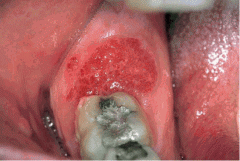
|
Peripheral ameloblastoma - Aetiology: unknown. Probably arises from dental lamina rests or basal epithelial cells - Description: painless, slow-growing, non-ulcerated, sessile red mass. Size 1-2cm. Posterior alveolar mucosa and gingiva of mandible most frequently affected. causes little or no bone erosion - Tests: Biopsy, histopathological exam - Differentials: pyogenic granuloma, peripheral giant cell granuloma, fibroma, SCC - Treatment: local surgical excision |
|

|
Amalgam tattoo - Aetiology: implantation of dental amalgam into the oral mucosa - Description: well-defined irregular or diffuse flat area with bluish-black discolouration of varying size - Tests: histopathological exam, radiographs - Differentials: pigmented nevi, lentigo, freckles, melanoma, normal pigmentation, other metal tattoo - No treatment required |
|

|
Ephelis - Aetiology: unknown. Increased melanin production - Description: solitary, well-demarcated asymptomatic round brown macules < 5mm in diameter. Vermilion border of lower lip most common site - Tests: histopathological exam - Differentials: lentigo, pigmented nevi, melanoma, drug-associated pigmentation, Peutz-Jeghers, Albright syndrome - Treatment: none, unless for aesthetic or diagnostic reasons |
|

|
Melanoma - Aetiology: unknown. UV radiation is a causative factor - Description: black or brown macule, plaque, or nodule that may be ulcerated, with an irregular margin and tendency to spread. Palate, upper gingiva and alveolar mucosa are most common sites - Tests: histopathological exam - Differentials: pigmented nevi, ephelis, lentigo, amalgam tattoo, Kaposi sarcoma - Treatment: surgical excision, chemotherapy, radiotherapy |
|

|
Addison disease - Aetiology: adrenal cortex destruction caused by autoimmunity, infections, tumours, amyloidosis - Description: diffuse, patchy dark brown pigmentation. Buccal mucosa, palate, lips, gingiva most common sites - Tests: measurement of plasma adrenocorticotrophic hormone (ATCH) and serum cortisol levels - Differentials: normal pigmentation, drug-induced pigmentation, Peutz-Jeghers - Treatment: steroid replacement |
|
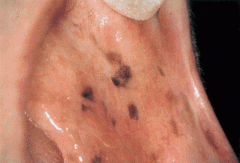
|
Peutz-Jeghers syndrome - Aetiology: autosomal dominant trait - Description: oval or round, black or brown macules or spots 1-10mm in diameter. Skin lesions consist of numerous perioral dark spots. Intestinal polyps - Tests: histopathological exam, radiography of GI tract - Differentials: ephelides, lentigo, normal pigmentation, Addison disease - Treatment: supportive. Surgical intervention in some cases |
|

|
Primary herpetic gingivostomatitis - Aetiology: HSV-1, rarely HSV-2 - Description: red, odematous, numerous coalescing vesicles, which rapidly rupture leaving painful small, round, shallow ulcers covered by yellow fibrin. New lesions continue to develop during the first 3-5 days. Ulcers heal in 10-14 days. Gingival lesions are almost always present - enlargement and odematous, painful erosions. High fever, headache, malaise, anorexia, irritability, bilateral sensitive lymphadenopathy. - Tests: smear, biopsy, serological tests - Differentials: aphthous ulcers, hand foot and mouth disease, herpangina, ANUG, erythema multiforme, pemphigus, desquamative gingivitis - Treatment: symptomatic. Systemic acyclovir or valaciclovir for severe cases |
|

|
Herpes zoster - Aetiology: shingles, reactivation of varicella-zoster virus. Predisposing factors - AIDS, leukaemia, lymphoma, other malignancies, radiation, immunosuppressive and cytotoxic drugs, old age - Description: prodromal symptoms (pain, tenderness, headache, pulpitis, malaise, fever) before oral or skin lesions. Clusters of vesicles develop, which evolved into pustules and ulcers. Lesions persists for 2-3 weeks. Unilateral location of lesions -oral lesions occur when 2nd and 3rd branches of the trigeminal nerve are involved. Trigeminal neuralgia is a common complication - Differentials: herpes simplex, erythema multiforme - Treatment: analgesics, sedatives for pain. Acyclovir, valaciclovir, famciclovir may help |
|

|
Herpangina - Aetiology: acute, self-limiting Coxsackievirus - Description: small, numerous vesicles, diffuse erythema and vesicles which rupture leaving painful ulcers that heal within 7-10 days. Appear on the soft palate, uvula, tonsillar pillars, posterior pharyngeal wall - Differentials: herpetiform ulcers, aphthous ulcers, primary herpes simplex, erythema multiforme, hand foot and mouth disease |
|

|
Hand foot and mouth disease - Aetiology: Coxsackievirus A16, acute and self-limiting - Description: small vesicles (5-30) that rapidly rupture, leaving painful, shallow ulcers (2-6mm in diameter) surrounded by a red halo. Skin lesions have the same features - fingers, toes, palms, soles, buttocks - Differentials: aphthous ulcers, herpes simplex, herpangina - Treatment: supportive |
|

|
Erythema multiforme - Aetiology: acute, subacute self-limting disease. Unknown aetiology. Probably immunologically mediated - Description: coalescing small vesicles that rupture within 2-3 days, leaving irregular, painful erosions covered by a necrotic psudeomembrane - lips, buccal mucosa, tongue, soft palate, floor of mouth. Skin - flat, round macules, papules or plaques. - Tests: histopathological examination - Differentials: primary herpetic gingivostomatitis, aphthous ulcers, erosive lichen planus, pemphigus vulgaris, pemphigoid |
|

|
Stevens-Johnson syndrome - Aetiology: severe form of erythema multiforme, triggered by drugs - Description: extensive vesicle formation, painful erosions covered by grayish-white or haemorrhagic pseudomembranes - Differentials: Behcet disease, pemphigus, pemphigoid, primary herpes simplex - Treatment: systemic steroids, Ab's if necessary |
|

|
Toxic epidermal necrolysis Aetiology: severe skin and mucous membrane disease triggered by drugs Description: diffuse erythema, vesicles, painful erosions on the lips, periorally, buccal mucosa, tongue, palate. Begins with low-grade fever, malaise, conjunctival burning sensation, skin tenderness, erythema. Blisters appear after 24 hours; skin is lifted up so the whole body appears scalded. Positive Nikolsky's sign Differentials: Stevens-Johnson, pemphigus vulgaris, severe and extensive burns Treatment: systemic steroids, antibiotics, electrolytes |
|
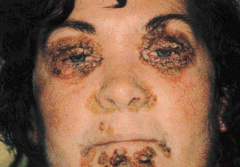
|
Pemphigus vulgaris - Aetiology: autoimmunity, desmoglein 1 and 3 main target antigens - Description: bullae which rapidly rupture, leaving painful erosions. Affects buccal mucosa, labial mucosa, palate, tongue, floor of mouth, gingiva. Positive Nikolsky's sign - Tests: histopathological exam, cytological exam, direct and indirect immunofluorescence - DIfferentials: MMP, bullous pemphigoid, linear IgA disease, toxic epidermal necrolysis, primary herpetic gingivostomatitis, erythema multiforme, erosive lichen planus, aphthous ulcers - Treatment: systemic steroids. Cyclosporin, azathioprine, mycophenolate mofetil |
|

|
Mucous membrane pemphigoid - Aetiology: autoimmunity - bullous pemphigoid antigen, laminin 5, B4, type VII collagen - Description: recurrent vesicles or bullae that rupture, leaving large, superficial painful ulcers. Repeated occurrences lead to epithelial atrophy or scarring. Gingival involvement common (similar to desquamative gingivitis). Ocular lesions - conjunctivitis can lead to blindness - Tests: histopathological exam, direct immunofluorescence - Differentials: bullous pemphigoid, linear IgA disease, pemphigus, erosive lichen planus, discoid lupus erythematosus, chronic ulcerative stomatitis - Treatment: steroids, rarely immunosuppressive drugs |
|

|
Bullous pemphigoid - Aetiology: autoimmunity - BP180, BP230 - Description: bullae on oral mucosa that soon rupture, leaving shallow ulcerations. Skin lesions always present - nonspecific rash with large, tense bullae that rupture - Tests: histopathological exam, direct and indirect immunofluorescence - Differentials: pemphigus, MMP, linear IgA, pemphigus gestationis - Treatment: systemic steroids, immunosuppressive drugs, dapsone |
|
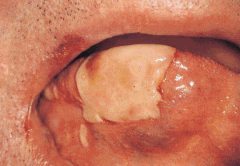
|
Linear IgA disease - Aetiology: autoimmunity - characterised by the linear deposition of IgA along the basement membrane zone - Description: bullae that rupture leaving superficial, non-specific ulcerations. Scarring conjunctivitis may occur. Similar features to MMP - Tests: histopathological exam, direct and indirect immunofluorescence - Differentials: MMP, bullous pemphigoid, pemphigus, pemphigoid gestationis - Treatment: dapsone, steroids |
|

|
Epidermolysis bullosa - Aetiology: genetic - Description: bullae usually in areas of friction which rupture leaving shallow ulcers and later atrophy and scarring. Dysplastic teeth in severe forms. Leukoplakia and SCC may develop on scars - Tests: histopathological and immunohistochemical exam - Differentials: pemphigus, MMP, bullous pemphigoid, linear IgA - Treatment: supportive; systemic steroids in severe cases |
|
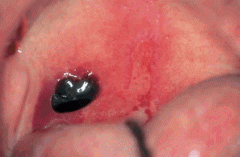
|
Angina bullosa haemorrhagica - Aetiology: unknown. Mild trauma and chronic use of steroid inhalers may play a role - Description: single or multiple haemorrhagic bullae that rupture spontaneously within hours or 1-2 days, leaving superficial ulcerations that heal without scarring in 5-10 days - Tests: histopathological exam, immunofluorescence - Differentials: MMP, bullous pemphigoid, linear IgA, pemphigoid gestationis, pemphigus, bullous lichen planus, amyloidosis - Treatment: symptomatic |
|

|
Traumatic ulcer - Aetiology: sharp tooth, rough fillings, dental instruments, biting, denture irritation - Description: single, painful ulcer with a smooth red or whitish-yellow surface, thin erythematous halo. Soft on palpation, heal without scarring - Tests: histopathological exam - Differentials: SCC, other malignancies, aphthous ulcer, syphilis, tuberculosis, systemic mycoses - Treatment: removal of traumatic factors, topical steroids may be used for a short time |
|
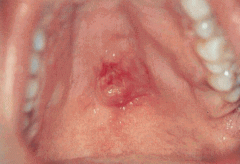
|
Necrotising sialadenometaplasia - Aetiology: unknown - Description: nodular swelling leads to painful crater-like ulcer 1-5cm in diameter with an irregular border. Mimics a carcinoma, usually on the posterior palate - Tests: histopathological exam - Differentials: SCC, mucoepidermoid carcinoma, adenoid cystic carcinoma, traumatic ulcer, malignant granuloma - Treatment: heals spontaneously within 4-8 weeks |
|

|
Necrotising ulcerative gingivitis - Aetiology: Fusobacterium nucleatum, Treponema vincentii and other bacteria play a role. Predisposing factors - stress, poor oral hygiene, local trauma, HIV - Description: painful necrosis of interdental papillae and gingival margins and formation of craters covered with a grey pseudomembrane - Differentials: herpetic gingivitis, desquamative gingivitis, leukaemia, scurvy, noma - Treatment: systemic metronidazole, oxygen-releasing topical agents, perio treatment |
|

|
Chronic ulcerative stomatitis - Aetiology: autoimmune disease with specific antinuclear antibodies directed against the stratified epithelium - Description: lesions appear in the form of desquamative gingivitis or as localised painful erythema and ulcerations. Painful superficial ulcerations are white, identical to OLP. Discoid lupus erythematosus may occur on the buccal mucosa and tongue - Tests: histopathological exam, direct and indirect immunofluorescence - Differentials: lichen planus, discoid lupus erythematosus, MMP, linear IgA, pemphigus - Treatment: local or systemic corticosteroids, hydroxychloroquine |
|

|
Syphilis - Aetiology: Treponema pallidum. Sexually transmitted disease - Description: Acquired syphilis Primary - chancre appears 3 weeks after the infection. Painless ulcer with a smooth surface, raised borders and an indurated base. Regional lymphadenopathy Secondary - 6-8 weeks after chancre. Mucous patches, macular syphilids Tertiary - 4-7 years, Gumma, atrophic or luteic glossitis, interstitial glossitis Congenital syphilis - high-arched palate, short mandible, Hutchinson's teeth, mulberry molars - Tests: dark-filed microscopic exam, serologic tests - Differentials: traumatic ulcer, aphthous ulcer, TB, herpes simplex, mono, candidiasis, erythema multiforme, lichen planus - Treatment: penicillin, erythromycin or cephalosporins |
|
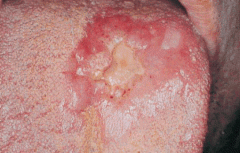
|
Tuberculosis - Aetiology: Mycobacterium tuberculosis - Description: painless, irregular with thin undermined border and vegetating surface, usually covered by a grey-yellowish exudate. Surrounding tissues are inflamed and indurated - Tests: sputum culture, histopathological exam, chest radiography - Differentials: systemic mycoses, carcinomas, syphilis, necrotising sialadenometaplasia, major aphthous ulcer - Treatment: anti-TB drugs |
|

|
Recurrent aphthous ulcer - Aetiology: unclear; Predisposing factors - trauma, allergy, genetic predisposition, endocrine disturbances, stress, haematological deficiencies, AIDS - Description: Minor - small, painful, round ulcers 3-6mm in diameter, whitish-yellow membrane surrounded by a thin red halo Major - deep painful ulcers, 1-2cm in diameter, persisting for 3-6 weeks, may scar Herpetiform - small, painful, shallow ulcers, 1-2mm in diameter, coalesce into larger irregular ulcers, multiple lesions (10-100), persist for 1-2 weeks and heal without scars - Differentials: herpes simplex, hand foot and mouth, chancre, Behcet's, erythema multiforme - Treatment: topical steroids, interalesional steroid injection or systemic steroids in low doses (10-20mg prednisone, 4-8 days) for severe cases |
|
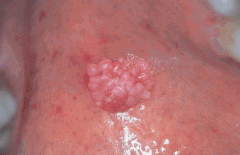
|
Papilloma - Aetiology: HPV - Description: painless, exophytic, well-circumscribed, pedunculated, white or greyish colour. Numerous fingerlike projections (cauliflower appearance), 0.5-1cm in size Differentials: verruca vulgaris, condyloma acuminatum, verruciform xanthoma |
|

|
Condyloma acuminata Aetiology: HPV types 6, 11. Occur frequently in HIV Description: single or multiple, small, sessile, well-demarcated, exophytic masses with a cauliflower-like surface. Whitish or normal colour, 0.5-1cm in size. Tests: histopathological exam, in-situ hybridisation, PCR Differentials: papilloma, verruca vulgaris, focal epithelilal hyperplasia, verruciform xanthoma Treatment: surgical excision, cryosurgery, CO2 laser, electrocautery, topical podophyllin |
|

|
Verruciform xanthoma Aetiology: unknown. May be a reaction to local trauma Description: painless, well-demarcated, sessile, slightly elevated lesion with a cauliflower-like surface. Reddish-yellow or normal colour, 0.5-2cm in size Tests: histopathological exam Differentials: papilloma, verruca vulgaris, condyloma acuminata, verrucous carcinoma Treatment: surgical excision |
|
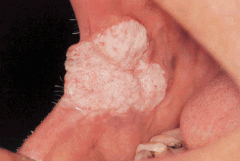
|
Verrucous leukoplakia Aetiology: rare clinical form of leukoplakia with a greater risk of malignant transformation Description: irregular, white, exophytic plaque with a papillary surface Tests: biopsy, histopathological exam Treatment: surgical excision |
|

|
Epulis fissuratum Aetiology: poorly fitting denture Description: multiple or single inflamed and elongated papillary folds in the mucolabial or mucobuccal grooves, mobile and ulcerated at the base of the folds Tests: histopathological exam Differentials: neurofibromatosis, fibroma, fibroepithelial polyp, SCC Treatment: surgical excision, construction of new denture |
|

|
Crohn's disease Aetiology: unknown, immunologically mediated Description: diffuse raised nodules resulting in a cobblestone appearance of mucosa. Abdominal pain, nausea, diarrhoea, weight loss, low-grade fever, rectal bleeding Tests: histopathological exam Differentials: orofacial granulomatosis, epulis fissuratum, pyogenic granuloma Treatment: topical steroids, systemic steroid, sulfasalazine |
|

|
Hyperplastic gingivitis Aetiology: dental plaque Description: interdental papillae and marginal gingiva appear diffuse, red, swollen, significantly increased in size (fibromatosis, oedema). Loss of normal stippling, gingival bleeding, pseudopocket formation Differentials: gingivitis of pregnancy, drug-induced gingival overgrowth, mouth-breathing gingivitis, leukaemia Treatment: OHI, elimination of causative factors, surgical reconstruction (severe) |
|
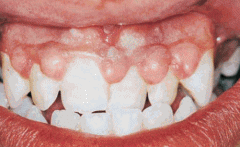
|
Mouth-breathing gingivitis Aetiology: mouth breathing, incomplete lip closure Description: swollen, red, dry, shiny gingiva, covering part of the crowns Differentials: drug-induced gingival overgrowth, hyperplastic gingivitis Treatment: gingivectomy, discontinuation of mouth breathing |
|

|
Drug-induced gingival overgrowth Aetiology: phenytoin, ciclosporin, calcium channel blockers Description: marginal gingiva and interdental papillae appear enlarged and firm, surface smooth, stippled or lobulated with little or no inflammation. Overgrowth may be localised or generalised and can partially or entirely cover the crowns of the teeth Differentials: hereditary gingival fibromatosis, mouth-breathing gingivitis, leukaemia, Crohn's disease, leukaemia Treatment: OHI, gingivectomy, discontinuation of drug |
|
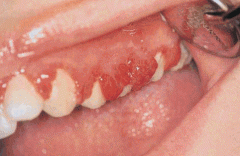
|
Pregnancy gingivitis Aetiology: pregnancy - oestrogen, progesterone, poor OH Description: significant gingival enlargement. Soft, oedematous, bright red with dense inflammation, hyperplastic and bleeds easily. Pregnancy granuloma may occur after the 1st trimester Differentials: scurvy, dental plaque-related gingivitis Treatment: good OH, may regress after pregnancy |
|

|
Gingival overgrowth due to leukaemia Aetiology: myelomonocytic and myelocytic leukaemia Description: diffuse enlargement of the gingiva, becomes oedematous, red, inflamed, bleeds spontaneously Differentials: scurvy, agranulocytosis, drug-related gingival overgrowth, hereditary gingival fibromatosis |
|
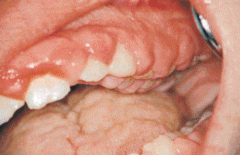
|
Hereditary gingival fibromatosis Aetiology: genetic, autosomal dominant Description: generalise gingival enlargement, firm, smooth, occasionally papillary or nodular, no or minimal inflammation, normal colour. Teeth may be covered. Maxillary gingiva most commonly affected Tests: histopathological exam Differentials: drug-related gingival overgrowth, Crohn's disease, leukaemia Treatment: gingivectomy, good OH |
|

|
Scurvy Aetiology: vitamin C deficiency Description: generalised swelling and redness of marginal and interdental gingiva, followed by bleeding, ulceration, tooth mobility. Petechaie, ecchymoses, spontaneous haemorrhage and delayed wound healing common Tests: measurement of ascorbic acid in blood Differentials: acute necrotising ulcerative gingivitis, herpetic gingivitis, leukaemia, agranulocytosis, thrombocytopenia purpura Treatment: vitamin C replacement |
|

|
Pyogenic granuloma Aetiology: local mild irritation or trauma Description: painless, exophytic nodular mass, pedunculated or sessile, with a deep red colour. Surface may be smooth or lobulated, often ulcerated, covered by a whitish-yellowish fibrinous membrane. Soft on palpation, tendency to haemorrhage easily. Grows rapidly Tests: histopathological exam Differentials: peripheral giant cell granuloma, haemangioma, Kaposi sarcoma, leiomyoma, metastatic neoplasms Treatment: surgical excision |
|

|
Peripheral giant cell granuloma Aetiology: local irritation or trauma Description: occurs exclusively on the gingiva or edentulous alveolar ridge. Well-circumscribed sessile or pedunculated mass, dark red, haemorrhages easily, may or may not be ulcerated, relatively elastic on palpation, 0.5-2cm in diameter Tests: histopathological exam Differentials: pyogenic granuloma, peripheral ossifying fibroma, Kaposi sarcoma Treatment: surgical excision |
|

|
Peripheral ossifying fibroma Aetiology: unknown. Derived from PDL or periosteum Description: occurs exclusively on the gingiva, more common in children, esp. females. Well-defined, firm mass, sessile or pedunculated, covered by smooth normal epithelium. Surface frequently ulcerated due to trauma, 0.5-2 cm in diameter. Common in incisor, canine region Tests: histopathological exam Differentials: pyogenic granuloma, peripheral giant-cell granuloma, fibroma, peripheral odontogenic tumours Treatment: surgical excision |
|

|
Fibroma Aetiology: reactive, fibrous hyperplasia in response to local irritation or trauma Description: asymptomatic, well-defined, firm, sessile or pedunculated tumour with a smooth surface of normal epithelium, 0.5-1.5cm in diameter Tests: histopathological exam Differentials: neurofibroma, peripheral ossifying fibroma, lipoma, myxoma, pleomorphic adenoma Treatment: surgical removal |
|

|
Lipoma Aetiology: unknown Description: asymptomatic, well-defined tumour, sessile or pedunculated, 0.5-3cm, yellowish or pink. Soft on palpation, occasionally fluctuant Tests: histopathological exam Differentials: myxoma, fibroma, mucocele, dermoid cyst Treatment: surgical removal |
|

|
Osteoma Aetiology: unknown Description: asymptomatic, well-defined, hard tumour covered by thin and smooth epithelium Tests: histopathological exam Differentials: exostoses, torus palatinus, fibroma Treatment: surgical excision |
|
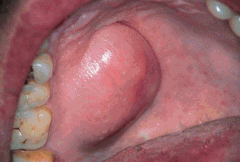
|
Pleomorphic adenoma Aetiology: unknown Description: asymptomatic, slow-growing, firm swelling, 2-3cm in size, covered by normal epithelium. Posterior palate is the most common site Tests: histopathological exam Differentials: other benign and malignant salivary gland tumours, necrotising sialadenometaplasia, lipoma Treatment: surgical excision |
|
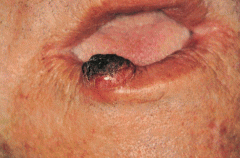
|
Keratoacanthoma Aetiology: uncertain, probably sunlight Description: rapidly growing, painless, well-circumscribed dome or bud shaped tumour 1-2cm in diameter, with a keratin crater in the centre Tests: histopathological exam Differentials: BSC, SCC Treatment: surgical excision, radiation. Some lesions may regress spontaneously |
|

|
Kaposi sarcoma Aetiology: herpervirus 8, immunosuppression Description: multiple or solitary red or brownish red patches or elevated plaques or tumours Tests: histopathological exam Differentials: pyogenic granuloma, peripheral giant-cell granuloma, haemangioma Treatment: interferon, chemotherapy, radiotherapy, surgical excision |
|

|
Mucoepidermoid carcinoma Aetiology: unknown Description: painless, proliferating, rubbery swelling that may be ulcerated. Tumour may be fluctuant and blue, resembling a mucocele Tests: histopathological exam Differentials: pleomorphic adenoma, mucocele, necrotising sialadenometaplasia Treatment: surgical excision |
|

|
Adenoid cystic carcinoma Aetiology: unknown Description: painful, slow-growing tumour that may ulcerate Tests: histopathological exam Differentials: pleomorphic adenoma, necrotising sialadenometaplasia, other malignant salivary tumours Treatment: surgical excision, radiation Other malignant salivary gland tumours (adenocarcinoma, malignant pleomorphic adenoma) present very similarly. Final diagnosis based on biopsy and histopathological exam |
|
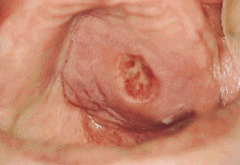
|
Non-Hodgkin's lymphoma Aetiology: unknown, viruses or radiation? Description: diffuse painless swelling which may ulcerate Tests: histopathological and immunohistochemical exam Differentials: eosinophilic ulcer, minor salivary gland neoplasma, SCC, dental abscess, systemic mycoses Treatment: radiotherapy, chemotherapy |
|

|
Actinomycosis Aetiology: actinomyces israelii Description: inflammatory, hard swelling, slow-growing. Multiple abscess and draining sinuses intraorally and on the skin are common Tests: bacteriological and histopathological exam Differentials: periapical or periodontal abscess, TB, systemic mycoses, other infections, benign and malignant tumours Treatment: penicillin, erythromycin, tetracycline, surgery |
|

|
Cutaneous leishmaniasis Aetiology: leishmania tropica Description: small papule, slow-growing. Red or brownish-red large nodule or tumour forms with a smooth, glistening surface, which ulcerates. Surrounding tissues are inflamed. Lips are a common site, extremely rare intraorally Tests: histopathological exam, microbiological identification, leishmanin skin tests Differentials: BCC, SCC, chancre, keratoacanthoma, systemic mycoses, sarcoidosis Treatment: meglumine antimonite, sodium stibogluconate, antimalarials |
|

|
Mucocele Aetiology: local minor trauma, duct rupture/obstruction, probably due to a mucous plug Description: Extravasation mucocele: duct rupture Mucous retention cyst: ductal dilation due to duct obstruction Painless, dome-shaped, solitary, bluish or translucent, fluctuant swelling Tests: histopathological exam Differentials: lymphangioma, haemangioma, lipoma, mucoepidermoid carcinoma, Sjogren syndrome Treatment: surgical excision, cryosurgery |
|

|
Ranula Aetiology: trauma or ductal obstruction Description: smooth, fluctuant, painless swelling on the floor of the mouth, lateral to the midline. Colour ranges from normal to a translucent bluish Tests: histopathological exam Differentials: dermoid cyst, abscess, haemangioma, lymphangioma, lymphoepithelial cyst Treatment: surgical removal, marsupialisation |
|

|
Osteosarcoma Aetiology: unknown Description: rapidly growing hard swelling. Progressively produces facial deformity Tests: histopathological exam, radiography, CT scans Differentials: chondrosarcoma, Ewing sarcoma, metastatic tumours, giant-cell tumour Treatment: surgical excision + radiotherapy, chemotherapy |
|
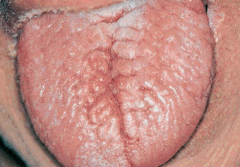
|
Sjogren syndrome Aetiology: unknown Description: recurrent enlargement of parotid, submandibular and lacrimal glands, lymphadenopathy, myositis Tests: histopathological exam, serological tests: antinuclear antibodies (ANA), anti-SSA, SS-B antibodies Differentials: collagen diseases, GvHD Treatment: steroids, immunosuppressants, artificial saliva and tears |
|

|
Actinic cheilitis Aetiology: long-term UV exposure Description: early stage - erythema, oedema followed by dryness, fine scaling of lower lip vermilion border. Epithelium becomes thin and smooth, small whitish-grey areas with red regions and scaly formations Tests: histopathological exam Differentials: leukoplakia, lichen planus, SCC Treatment: sun protection, vermilionectomy (severe) |
|

|
Angular cheilitis Aetiology: reduced vertical dimension, mechanical trauma, Candida albicans, staphylococci, streptococci, iron-deficiency anaemia, riboflavin deficiency Description: erythema, maceration, fissuring, erosions, crusting at the commissures. Burning sensation, feeling of dryness Treatment: correction of vertical dimension, topical steroids, antifungal ointments |
|
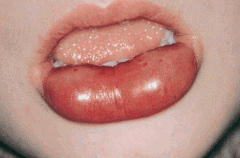
|
Angioneurotic oedema Aetiology: inherited or acquired (food allergy, chemicals, infections, stress) Description: painless , smooth swelling of the lips. May involve other intraoral regions, glottis Differentials: emphysema, cellulitis Treatment: antihistamines, systemic steroids |

